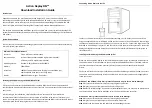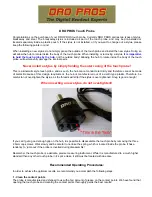
7
vertical axis. It allows to correct centering between
the photocells in installations with fixing surfaces
that are parallel to each other.
For setting up the horizontal axis, loosen up the
two screws indicated with number
1
in the
picture
6
, adjust the movable part until reaches the ideal
position, then screw the two screws number
1
back. For setting up vertical axis, rotate the screw
indicated with number
2
in the
picture 6
, clockwise
or counterclockwise until reaches the optimum
position.
Control of the correct alignment between the
photocells
The photocell RX has one red led (indicated with
L
in
the
pictures 1 and 2
). Its brightness is proportional
to the power of the received signal and at the same
time, it indicates the correct alignment between
the photocells. Bigger is the brightness, greater it
is the power received and therefore it is better the
alignment. Even if the photocell RX works also with
low signal received, it is recommend to perform the
best alignment possible, to guarantee an efficient
functioning even in cases of fog, dust or rain.
Connections of the outputs of the photocells RX
The outputs of the photocells RX are relays contacts
free of tension.
Caution: by convention the switches NC (normally
close) and NO (normally open) indicates in this
instruction the reference to the photocells RX
activated by the infrared ray.
Description of the outputs of the terminal blocks:
–
Terminal n°3 switch NC (normally close)
–
Terminal n°4 switch COMUNE for the terminals
3 and 5
–
Terminal n°5 switch NO (normally open)
Usually, for the automatic entrances, switch NC
(terminals 3-4) is used because, if there is an
obstacle between the photocells, the switch NC
opens.
For the courtesy function, it is used the switch
NO (terminals 4-5) because, if there is an obstacle
between the photocells, the switch NO closes.
5
Testing
Testing of one pair of photocell
The testing allows to verify the correct functioning
6
Maintenance
Do scheduled maintenance every 6 months, for
checking cleaning and functioning of all of the
photocells.
In case of dirt, wet, insects or anything else, clean
the photocell and run again the testing process.
In case of oxide on the circuit board, please consider
the replacement.
7
Disposal
The product must be always uninstall by the technical
and qualified staff, using appropriate processes for the
correct removal of the product.
This product is made of different materials, some
of them could be recycled others must be disposed
through recycling or disposal systems established by
local regulations for this product.
It is forbidden to dispose the product into the house
garbage. Make the “separate collection” for disposal
according to the methods established by local
regulations; otherwise return the product to the seller
when you buy the new equivalent product.
Local regulations may provide for heavy penalties for
illegal disposal of this product.
Caution
: some parts of the product may
contain pollutants and hazardous, if
thrown they may cause dangerous effects
to the environment and to the human
health.
of the photocells and the possible interference with
other transmission devices with infrared light that
are installed nearby.
Activate the control device to which are connected
the photocells.
With something cylindrical of about 50mm of
diameter, break off many times the beam of light
between the photocells. Repeat the same operation
positioning near the photocell TX, near the
photocell RX and in the center between the two. If
the control device notice correctly each interruption
at all points, the testing is successfully completed. In
the case of two or more pairs of photocells installed,
repeat the same step taking care to verify possible
interferences between them.

























